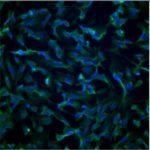Link to Pubmed [PMID] – 12678729
Curr Med Chem Anticancer Agents 2002 Sep;2(5):627-44
DNA is prone to structural polymorphism: its three-dimensional structure can differ markedly from the classical double helix. Nucleic acid structures composed of more than two strands have also been observed. The guanine-rich sequence of both the telomere and centromere can form a quadruplex based on G-quartets while the complementary cytosine-rich strand can fold into an intercalated tetramer called the i-motif. The G-quartet is a gold mine for structural biologists and the telomere has become a target for anti-cancer drug design since it was observed that deregulation of telomerase favors proliferation of certain tumors. Other DNA sequences may adopt unusual conformations. Polypurine-polypyrimidine sequences capable of forming a triple-stranded structure called H-DNA are found abundantly in the eukaryotic genome and may play a significant role in DNA metabolism, transcription and replication. Triplex-forming oligonucleotides are currently being developed as “anti-gene” agents. Unusual DNA structures may therefore be implicated in fundamental processes such as gene expression and represent unique targets for both structural-specific and sequence-specific agents. In this review, we present work characterizing some of these unusual conformations in terms of structure, stability and formation kinetics and discuss their biological implications.

